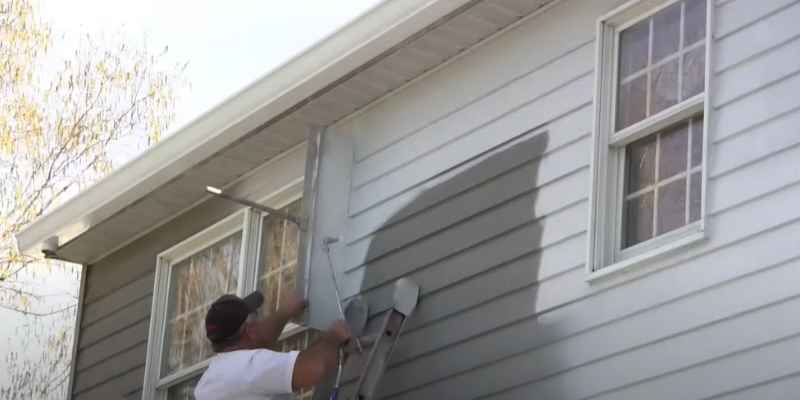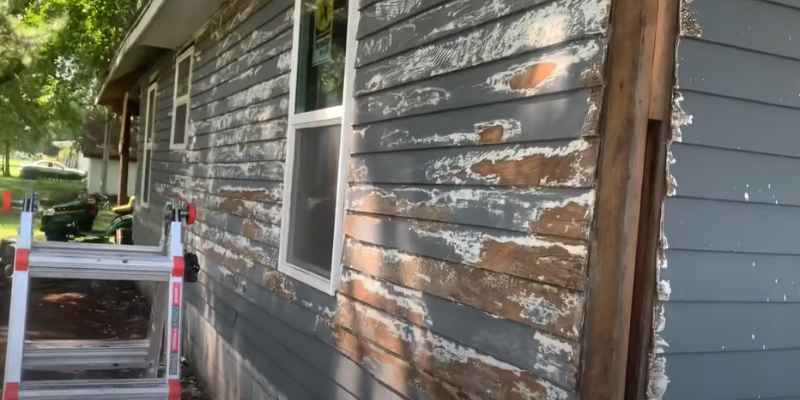Yes, you can paint cedar. Painting cedar is a popular way to enhance its appearance and protect it from the elements.
However, there are a few important steps to follow to ensure a successful paint job. Firstly, you need to prepare the cedar by cleaning it and removing any dirt, grime, or loose paint. Next, you should prime the wood with a high-quality primer specifically designed for cedar.
After the primer has dried, you can apply a coat or two of exterior paint in your desired color. It’s crucial to choose a paint that is compatible with cedar and provides long-lasting protection. Regular maintenance and touch-ups may also be needed to keep the paint looking fresh. Overall, painting cedar can be a great way to maintain its beauty and extend its lifespan.
Preparing Cedar For Painting
Before you dive into painting your cedar, it’s crucial to properly prepare the surface. By taking the time to clean, sand, and prime the cedar, you can ensure a smooth and long-lasting finish. Let’s walk through the steps of preparing cedar for painting.
Cleaning And Sanding The Cedar
To start, cleaning the cedar is essential to remove any dirt, grime, or mildew that may be present. This ensures that the paint adheres properly and prevents any imperfections from showing through. Here’s how you can effectively clean your cedar:
- Begin by using a mild detergent mixed with water. Scrub the surface of the cedar using a soft-bristle brush to remove any dirt or debris.
- Rinse the cedar thoroughly with clean water to remove any remaining soap residue.
- Allow the cedar to dry completely before moving on to the next step.
- Once the cedar is dry, it’s time to sand the surface. Sanding helps smooth out any imperfections and provides a better surface for the paint to adhere to.
- Use a fine-grit sandpaper and lightly sand the cedar in the direction of the wood grain. Be sure to sand any rough spots or previous paint marks until the surface feels smooth to the touch.
- After sanding, wipe away any dust using a damp cloth to ensure a clean painting surface.
Priming The Cedar Surface
Now that the cedar is clean and sanded, it’s important to prime the surface before applying the paint. Priming helps to seal the wood, provides an even base, and enhances the durability of the paint. Follow these steps to prime the cedar:
- Choose a high-quality exterior wood primer that is suitable for cedar. Look for a primer that specifically mentions cedar on the label.
- Stir the primer thoroughly before applying it to the cedar.
- Using a brush or roller, apply a thin and even coat of primer to the cedar surface, working in the direction of the wood grain.
- Allow the primer to dry according to the manufacturer’s instructions. Usually, it takes around 2-3 hours, but it’s best to check the specific drying time mentioned on the label.
- Inspect the primed surface for any areas that may need additional priming or touch-ups.
Once you’ve completed these preparations, the cedar is now ready for the final coat of paint. Remember, a proper and thorough preparation process ensures the best results and helps your painted cedar look its absolute best.

Choosing The Right Paint For Cedar
Painting cedar can enhance its appearance and protect it from the elements. Choose the right paint to ensure long-lasting results.
Understanding The Types Of Paint For Cedar
When it comes to painting cedar, it is important to understand the different types of paint that are available. Now let’s dive into the details!
Considerations For Exterior And Interior Painting
When painting cedar, whether it is for an exterior or interior application, there are a few factors to consider. Let’s take a closer look at each.
Understanding The Types Of Paint For Cedar
To ensure a successful paint job on cedar, it is crucial to use the right type of paint. There are two primary options: oil-based paint and latex paint.
Oil-based Paint
Oil-based paint is a popular choice for painting cedar, especially for exterior applications. It offers excellent durability and protection against moisture and weather conditions. Additionally, oil-based paint penetrates the wood fibers, providing better adhesion and a longer-lasting finish.
Latex Paint
Latex paint, also known as water-based paint, is a versatile option for both interior and exterior cedar surfaces. It dries quickly, cleans up easily with soap and water, and has low levels of volatile organic compounds (VOCs). However, latex paint may not provide the same level of durability as oil-based paint for exterior applications.
Considerations For Exterior Painting
When painting cedar exteriors, additional considerations come into play. The exterior paint should offer protection against UV rays, moisture, and mildew. It is recommended to choose a paint specifically formulated for outdoor use and designed to withstand the elements.
Considerations For Interior Painting
For cedar interiors, the main goals are to enhance the natural beauty of the wood and protect it from wear and tear. A paint with a suitable sheen, such as satin or semi-gloss, can highlight the wood grain while providing a durable and washable surface. Additionally, consider using a primer to ensure proper adhesion and an even finish.
Wrapping Up
In conclusion, choosing the right paint for cedar is essential to achieve a long-lasting, beautiful finish. Consider factors like the type of paint (oil-based or latex), the location (exterior or interior), and the desired durability and protection. Consulting with a professional or following the manufacturer’s recommendations will ensure the success of your paint project.
Applying Paint To Cedar
Cedar can be painted successfully if the right steps are followed. Proper preparation, priming, and selecting the right paint are essential for a long-lasting and attractive finish on cedar surfaces.
When it comes to painting cedar, a material known for its natural beauty and durability, it is important to properly prepare the surface and choose the right paint to ensure a long-lasting finish. In this article, we will explore the pros and cons of brushing versus spraying paint on cedar, as well as provide some tips for achieving a smooth and even finish.
Brushing Vs. Spraying
Before you begin painting your cedar, you may be wondering whether it is best to use a brush or a sprayer. Both methods have their advantages and it ultimately depends on your personal preference and the scale of the project.
If you choose to brush the paint onto the cedar, you can have more control over the application and ensure that every nook and cranny is covered. This method is ideal for smaller projects or areas that require precision, such as trims and corners.
On the other hand, if you opt for spraying the paint onto the cedar, you can cover a larger surface area in a shorter amount of time. This method is perfect for larger projects, such as painting an entire fence or siding.
Tips For Achieving A Smooth And Even Finish
Now that you have decided on the method of application, here are some tips to help you achieve a smooth and even finish when painting cedar:
- Prepare the surface: Before painting, make sure to clean the cedar surface thoroughly and remove any dirt, dust, or loose particles. This will ensure better adhesion of the paint.
- Prime the cedar: Applying primer before painting cedar is essential to seal the wood and create a smooth surface. Choose a primer specifically formulated for cedar to enhance its natural beauty and protect it from moisture.
- Choose the right paint: Selecting a high-quality, exterior-grade paint is crucial for painting cedar. Look for a paint that is specifically designed for wood surfaces and offers protection against UV rays and moisture.
- Use the correct brush or sprayer: If you are using a brush, choose one with bristles that are suitable for applying paint to wood. For sprayers, make sure to use a nozzle that is appropriate for the paint consistency and desired coverage.
- Apply thin coats: Rather than applying a thick coat of paint all at once, it is better to apply several thin coats. This allows the paint to dry evenly and minimizes the risk of drips or uneven coverage.
- Allow sufficient drying time: Be patient and allow each coat of paint to dry fully before applying the next one. Follow the manufacturer’s recommended drying time to ensure a durable and long-lasting finish.
- Maintain the painted cedar: To extend the lifespan of the painted cedar, regularly inspect the surface for any signs of wear or damage. Touch up any areas that require attention to keep your paint job looking fresh and vibrant.
By following these tips and considering whether to brush or spray the paint, you can achieve a smooth and even finish when painting cedar. Remember, proper preparation and using high-quality materials are the keys to a successful and long-lasting paint job.
Maintaining A Painted Cedar Surface
Once you have painted your cedar surface, it is important to implement regular maintenance to keep it looking fresh and vibrant for years to come. In this section, we will discuss two key aspects of maintaining a painted cedar surface: regular cleaning and inspections, and touching up paint and addressing any issues.
Regular Cleaning And Inspections
Making sure your painted cedar surface is regularly cleaned is crucial for its longevity. Regular cleaning not only helps to remove dirt and grime, but it also allows you to identify any potential issues that may require attention. Follow these steps for effective cleaning:
- Start by gently rinsing the painted cedar surface with water using a garden hose or pressure washer set on a low setting. Be cautious not to use high pressure, as it can damage the paint.
- Next, mix a mild detergent with water in a bucket and apply it to the surface using a soft-bristle brush or sponge. Scrub gently in a circular motion to remove any stubborn stains or dirt.
- Rinse the surface thoroughly with water to ensure all the detergent residue is removed.
- Allow the surface to dry completely before proceeding with any further maintenance.
Regular inspections are as important as cleaning. Inspect the painted cedar surface for any signs of paint peeling, cracking, or fading. If you notice any issues, address them promptly to prevent further damage. Regular inspections help you catch problems early on, allowing for easier and less costly repairs.
Touching Up Paint And Addressing Any Issues
Even with proper care, painted cedar surfaces may require some touch-ups over time. Here are the steps to follow when addressing any paint issues:
- Start by thoroughly cleaning the affected area using the cleaning steps outlined above. This ensures a clean surface for effective touch-up paint application.
- Inspect the area to determine the extent of the damage. If there are areas with peeling or chipped paint, carefully scrape off the loose paint using a scraper or putty knife.
- Once the surface is clean and free of loose paint, sand the area lightly with fine-grit sandpaper to create a smooth surface.
- Wipe away any dust or debris using a damp cloth.
- Apply a thin layer of primer to the spot and let it dry according to the manufacturer’s instructions.
- Finally, using a brush or roller, apply the touch-up paint to the area, making sure to blend it seamlessly with the surrounding paint.
By promptly addressing any paint issues and touching up as necessary, you can maintain the overall appearance and protection of your painted cedar surface for years to come.

Common Mistakes To Avoid
When it comes to painting cedar, there are a few common mistakes that many people make. By being aware of these mistakes and avoiding them, you can ensure a successful painting project that enhances the beauty and longevity of your cedar surfaces.
Not Properly Preparing The Cedar Surface
One of the most important steps in painting cedar is preparing the surface properly. Without proper preparation, the paint may not adhere well, leading to peeling and flaking over time. To avoid this, make sure to:
- Thoroughly clean the cedar surface with a mild detergent and a soft brush.
- Remove any existing paint, stains, or sealants using a paint stripper or sandpaper.
- Repair any cracks, holes, or imperfections with wood filler and sand it smooth.
By taking the time to properly prepare the cedar surface, you create a smooth and clean canvas for the paint to adhere to, ensuring a long-lasting and beautiful finish.
Using The Wrong Type Of Paint
Choosing the right type of paint is crucial when painting cedar. Using the wrong type can result in poor adhesion, discoloration, and even damage to the wood. To avoid this mistake:
- Use an exterior latex paint specifically formulated for wood surfaces.
- Avoid using oil-based or alkyd paints, as they can trap moisture and lead to rot.
- Select a paint with UV protection to prevent fading and damage from the sun.
By selecting the right type of paint for your cedar, you ensure a durable and fade-resistant finish that will withstand the elements.
Skipping Necessary Coats Of Paint
When painting cedar, it’s important to apply the proper number of coats for optimal coverage and protection. Skipping coats can result in uneven color, poor durability, and a shorter lifespan of the paint job. To avoid this mistake:
- Apply a primer coat to seal the wood and provide a smooth base for the paint.
- Follow up with two or more coats of paint, allowing sufficient drying time between each coat.
- Ensure complete coverage by using a high-quality brush or roller and applying the paint evenly.
By applying the necessary coats of paint, you create a strong and long-lasting finish that protects the cedar and keeps it looking great for years to come.
Neglecting Necessary Maintenance
Maintaining your painted cedar surfaces is essential to prolonging their lifespan and keeping them looking their best. Neglecting maintenance can lead to peeling, cracking, and the need for more frequent repainting. To ensure your painted cedar stays in top shape:
- Regularly clean the surface with a mild detergent to remove dirt and grime.
- Inspect for any signs of damage, such as peeling or chipping, and repair promptly.
- Consider applying a fresh coat of paint every few years to maintain protection and appearance.
By staying on top of maintenance tasks, you can extend the life of your painted cedar surfaces and enjoy their beauty for years to come.
Conclusion
To wrap up, painting cedar can be an effective way to enhance its appearance and protect it from the elements. However, it is important to prepare the wood properly and choose the right type of paint for optimal results. By following the tips and guidelines mentioned in this blog post, you can successfully paint cedar and achieve a beautiful and long-lasting finish.
So, go ahead and transform your cedar surfaces with confidence!


